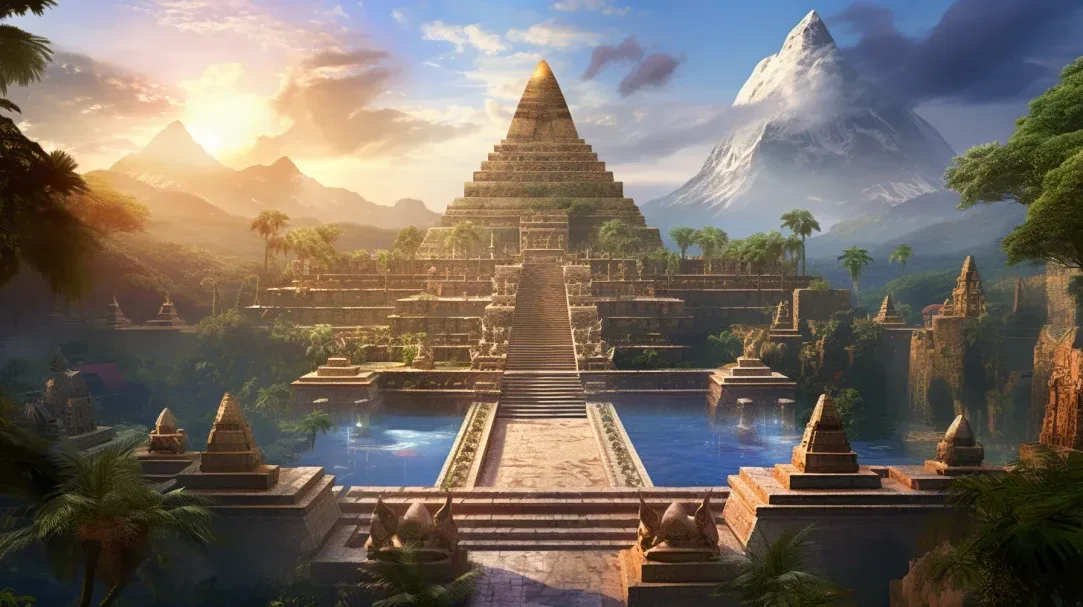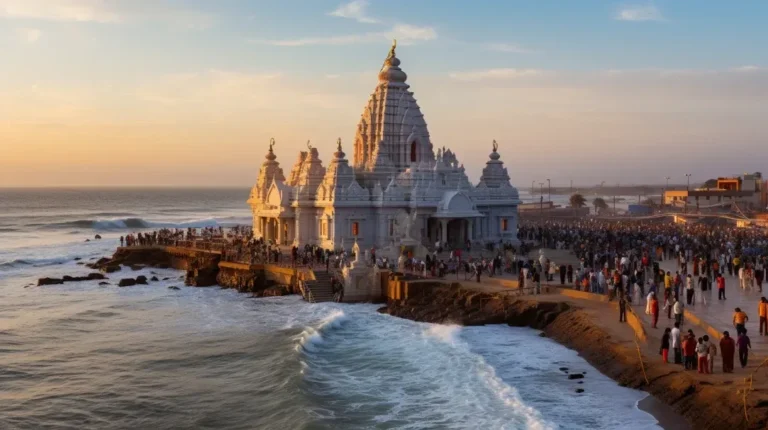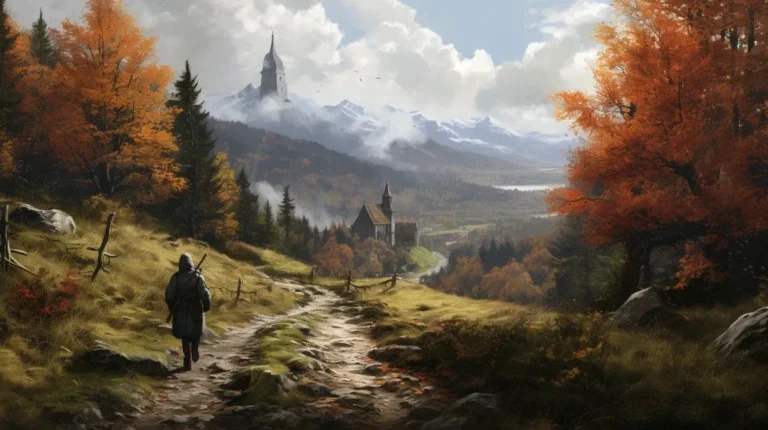Journey to Enlightenment: Discovering the World’s Most Sacred Sites
Journey to Enlightenment: Discovering the World’s Most Sacred Sites is a captivating exploration of the ancient and revered places that have inspired spiritual seekers for centuries. From the serene temples of Southeast Asia to the majestic peaks of the Himalayas, this compelling journey takes readers on a global adventure, unveiling the hidden wisdom and transformative power that lie within these sacred spaces.
With a professional and informative writing style, this book is designed to provide a comprehensive understanding of the significance and cultural importance of these sites. Delving into the mystical shrines of Central America, the holy sites of the Middle East, and the spiritual centers of India, readers will discover the profound historical and spiritual connections that have shaped these locations.
Whether you are a seasoned traveler or simply seeking a deeper understanding of the world’s sacred traditions, this book offers a gateway to enlightenment.
Key Takeaways
- Sacred sites around the world, such as Angkor Wat, Borobudur, Tikal Temple, and Copán Ruins, are known for their intricate carvings, towering spires, and serene courtyards.
- These sacred sites serve as centers of learning and community gatherings, steeped in centuries-old traditions and acting as repositories of history, tradition, and faith.
- The sacred sites of the Himalayas, adorned with monasteries, temples, and hermitages, offer a space for introspection and self-discovery, acting as a gateway to the divine.
- Jerusalem, Mecca, and the Church of the Holy Sepulchre in the Middle East are significant holy sites, attracting pilgrims from around the world and serving as repositories of history, tradition, and faith.
Ancient Temples of Southeast Asia
Exploring the architectural marvels of ancient temples in Southeast Asia reveals the rich spiritual heritage of the region. These temples, with their intricate designs and majestic structures, stand as testaments to the devotion and creativity of the people who built them. From the Angkor Wat in Cambodia to the Borobudur in Indonesia, each temple tells a story of a bygone era, where faith and art merged seamlessly. The intricate carvings, towering spires, and serene courtyards create an atmosphere of tranquility and reverence. These temples were not merely places of worship, but also centers of learning and community gatherings. Through their timeless beauty and sacred significance, they continue to inspire awe and admiration in visitors from around the world.
As we delve into the ancient temples of Southeast Asia, we embark on a spiritual journey that takes us from the earthly realm to the realm of the divine. But our exploration of sacred sites does not end here. The sacred mountains of the Himalayas await, where ancient traditions and breathtaking landscapes converge, inviting us to explore the heights of spiritual enlightenment.
Sacred Mountains of the Himalayas
Continuing our exploration of Southeast Asia’s ancient temples, we now turn our attention to the sacred mountains of the Himalayas, where ancient traditions and awe-inspiring landscapes converge.
Nestled amidst the towering peaks, these sacred mountains hold a profound spiritual significance for the people of the region. The Himalayas, with their majestic beauty and ethereal atmosphere, have long been regarded as a gateway to the divine. The towering peaks, shrouded in mist and snow, seem to touch the heavens themselves, inviting pilgrims and seekers alike to embark on a spiritual journey.
These sacred mountains are adorned with monasteries, temples, and hermitages, where devotees meditate and seek enlightenment. The serenity and tranquility of these sacred places create a space for introspection and self-discovery.
As we journey from the Himalayas to the mystical shrines of Central America, we continue our quest for spiritual awakening, guided by the wisdom of ancient traditions and the sacred sites that bear witness to the human quest for enlightenment.
Mystical Shrines of Central America
The mystic shrines of Central America hold a profound spiritual significance for those who seek enlightenment in this ancient land. These sacred sites, scattered throughout the region, are steeped in centuries-old traditions and carry the wisdom of indigenous cultures. They offer a glimpse into the rich tapestry of Central American spirituality, inviting visitors to connect with the divine and explore their inner selves.
One such mystical shrine is the Tikal Temple in Guatemala. This awe-inspiring structure, towering above the rainforest canopy, was once a sacred site for the ancient Maya civilization. Its grandeur and intricate carvings serve as a testament to the Maya’s deep reverence for the natural world and their profound understanding of cosmic forces.
Another mystical shrine is the Copán Ruins in Honduras, known for its intricately carved stelae and hieroglyphs. These ancient symbols tell stories of creation, myth, and spirituality, offering a glimpse into the beliefs and rituals of the Maya people.
The table below provides a glimpse into the mystical shrines of Central America:
| Shrine | Location |
|---|---|
| Tikal Temple | Guatemala |
| Copán Ruins | Honduras |
| Chichén Itzá | Mexico |
| Monte Albán | Mexico |
These sacred sites are not only places of worship but also serve as portals to higher realms of consciousness. They beckon seekers to embark on a spiritual journey, to delve into the depths of their souls and discover the interconnectedness of all things.
Visiting these mystical shrines allows one to tap into the ancient wisdom that continues to resonate in the land. It is a chance to reconnect with the spiritual essence of Central America and find solace, inspiration, and enlightenment in its sacred spaces. May these shrines continue to guide and inspire all who seek a deeper understanding of themselves and the world around them.
Holy Sites of the Middle East
One of the most revered destinations for seekers of spiritual enlightenment is the Middle East, home to a multitude of holy sites that hold deep religious significance.
From the ancient city of Jerusalem, with its Western Wall and Dome of the Rock, to the sacred city of Mecca, where millions of Muslims gather each year for the Hajj pilgrimage, the Middle East is a land of profound spiritual experiences.
The region also boasts the magnificent Church of the Holy Sepulchre, the site of Jesus’ crucifixion and burial, and the serene Mount Sinai, where Moses received the Ten Commandments.
These holy sites are not only places of worship, but also repositories of history, tradition, and faith. They inspire pilgrims and visitors alike to delve deeper into their own spirituality and seek enlightenment in the divine.
Spiritual Centers of India
India, a land steeped in spirituality and mysticism, is home to numerous spiritual centers that hold immense significance for millions of people around the world.
These sacred sites, whether ancient temples, pilgrimage destinations, or ashrams, offer a profound connection to the divine and serve as places of reflection, introspection, and enlightenment.
From the sacred city of Varanasi to the serene mountains of Rishikesh, India’s spiritual centers beckon seekers from all walks of life to embark on a transformative journey of self-discovery and spiritual growth.
Sacred Sites’ Significance
As one explores the sacred sites of India, it becomes evident that these spiritual centers hold immense significance for seekers of enlightenment. From the majestic temples of Varanasi to the serene ashrams in Rishikesh, these sacred sites are not just physical locations, but gateways to profound spiritual experiences.
Each site is steeped in ancient wisdom and carries the energy of countless generations of seekers who have come before. They are places where one can connect with the divine, immerse oneself in the sacred rituals and practices, and experience a deep sense of inner peace and transformation.
These sites serve as reminders of the eternal truths that lie within us, and their significance lies in their ability to guide and inspire individuals on their own spiritual journeys.
Popular Spiritual Destinations?
Renowned for their spiritual significance, the sacred sites of India attract countless seekers from around the world. These popular spiritual destinations offer a profound connection to the divine and a chance to explore one’s inner self. The diverse spiritual centers of India cater to various religious beliefs and practices, ensuring that every seeker finds solace and enlightenment. From the bustling Varanasi, where the Ganges River flows and ancient rituals are performed, to the tranquil Dharamshala, home to the Dalai Lama and Tibetan Buddhist teachings, each destination holds its own unique charm. To evoke an emotional response, imagine standing in the presence of such awe-inspiring places. Here is a glimpse of these spiritual centers:
| Destination | Significance | Spiritual Practice |
|---|---|---|
| Varanasi | Oldest inhabited city, Hindu rituals, Ganges River | Meditation, yoga, spiritual ceremonies |
| Bodh Gaya | Where Buddha attained enlightenment | Buddhist meditation, pilgrimage, study of Buddhist texts |
| Rishikesh | Yoga capital of the world | Yoga, meditation, ashram stays |
| Dharamshala | Tibetan Buddhist teachings, Dalai Lama’s residence | Meditation, Buddhism, mindfulness practices |
As we explore the spiritual centers of India, let us now turn our attention to the ancient stone circles of Europe, where mystical energies and ancient wisdom await.
Ancient Stone Circles of Europe
Europe is home to a significant number of ancient stone circles, which have captivated scholars and enthusiasts alike with their mysterious origins and spiritual significance. These awe-inspiring structures, scattered across the continent, stand as enduring reminders of the ancient civilizations that once thrived in Europe.
From the famous Stonehenge in England to the lesser-known Ring of Brodgar in Scotland, these stone circles evoke a sense of wonder and curiosity. The purpose of these circles remains shrouded in mystery, with theories ranging from astronomical observatories to ceremonial sites.
Yet, regardless of their original purpose, these ancient stone circles continue to inspire a deep sense of connection to the past and a reverence for the natural world. Exploring these sacred sites allows one to delve into the rich tapestry of European history, to ponder the spiritual significance of these ancient structures, and to appreciate the profound wisdom of our ancestors.
Sacred Waterfalls of South America
As you embark on a journey through the sacred waterfalls of South America, prepare to witness the awe-inspiring healing powers of these natural wonders.
From the thunderous cascade of Iguazu Falls to the misty serenity of Kaieteur Falls, indigenous rituals and traditions have long revered these sites as sources of spiritual rejuvenation.
However, as we explore these enchanting landscapes, it is crucial to consider the environmental impact and promote conservation efforts for future generations to experience the profound beauty and tranquility of these sacred waterfalls.
Healing Powers of Waterfalls
How do the sacred waterfalls of South America possess healing powers? These majestic wonders of nature are believed to hold a unique energy that can restore both body and spirit. As the water cascades down the rugged cliffs, it creates a powerful force that cleanses and purifies, washing away negativity and revitalizing the soul.
The sound of the rushing water is hypnotic, creating a sense of tranquility and inner peace. The mist that rises from the falls is said to carry with it the healing properties of the surrounding vegetation, infusing the air with a potent blend of minerals and nutrients. Visitors are often encouraged to immerse themselves in the cascading water, allowing it to wash away their ailments and bring about a sense of renewal.
These sacred waterfalls are not just natural wonders, but also places of profound healing and transformation, where one can connect with the powerful forces of nature and find solace.
Transitioning into the subsequent section about indigenous rituals and traditions, these sacred sites have long been revered by indigenous communities who have developed their own rituals and practices to harness the healing powers of the waterfalls.
Indigenous Rituals and Traditions
Indigenous communities in South America have long embraced and incorporated sacred rituals and traditions into their interactions with the powerful forces of the region’s sacred waterfalls. These rituals serve as a way to connect with the spiritual realm and honor the natural world. Here are three examples of indigenous rituals and traditions associated with the sacred waterfalls of South America:
- Offering ceremonies: Indigenous communities often perform elaborate ceremonies to honor the waterfalls. They offer gifts such as flowers, fruits, and sacred herbs, believing that these offerings will please the spirits and ensure their continued protection and abundance.
- Cleansing rituals: Waterfalls are seen as purifying and healing places. Indigenous people engage in cleansing rituals, where they immerse themselves in the waterfall’s waters to cleanse their bodies and spirits, seeking physical and spiritual renewal.
- Prayer and meditation: Indigenous communities gather around these sacred sites to engage in prayer and meditation. They seek guidance, healing, and enlightenment, connecting with the divine and finding solace in the powerful energy of the waterfalls.
These indigenous rituals and traditions demonstrate a deep reverence for nature and a spiritual understanding of the interconnectedness of all living beings. They provide a profound insight into the rich cultural heritage of South America’s indigenous communities.
Environmental Impact and Conservation
The environmental impact and conservation efforts surrounding the sacred waterfalls of South America have become a priority for many organizations and individuals. These magnificent natural wonders not only hold great spiritual significance but also play a crucial role in maintaining the delicate ecosystem of the region.
To raise awareness and protect these sacred sites, various initiatives have been undertaken, focusing on sustainable tourism, habitat restoration, and community engagement. Organizations like the Sacred Waterfalls Conservation Alliance work tirelessly to preserve the biodiversity and cultural heritage associated with these waterfalls. Through their efforts, they ensure that future generations can continue to experience the awe-inspiring beauty and spiritual connection that these sacred waterfalls offer.
As we explore the environmental impact and conservation of South America’s sacred waterfalls, we gain a deeper understanding of the interconnectedness between nature and spirituality.
Transitioning to the subsequent section, let us now delve into the indigenous sacred sites of North America.
Indigenous Sacred Sites of North America
Sacredness permeates the landscapes of North America’s indigenous peoples through their veneration of ancestral sites. These sacred sites hold profound spiritual significance, connecting native communities to their past, present, and future.
Here are three examples of Indigenous sacred sites in North America:
- Bear Butte, South Dakota: A place of great importance to the Lakota, Cheyenne, and other tribes, Bear Butte is considered a sacred mountain. It is a site for vision quests, prayer ceremonies, and spiritual retreats.
- Chaco Canyon, New Mexico: This ancient Puebloan complex is home to impressive ruins and celestial alignments. It served as a center for trade, ceremony, and astronomical observations, reflecting the deep connection between the people and the cosmos.
- Auyuittuq National Park, Canada: Located in the Arctic, this park holds immense spiritual significance for the Inuit people. It encompasses stunning landscapes, glaciers, and mountains that are believed to be inhabited by powerful spirits and deities.
These sites are not only sacred to Indigenous peoples but also offer valuable insights into their rich cultural heritage and traditions. Exploring these sites allows us to appreciate the profound spirituality and wisdom embedded in the land and its people.
Pilgrimage Routes of the World
Pilgrimage routes around the world provide a transformative journey for seekers of spiritual enlightenment. These ancient paths, walked by millions of pilgrims throughout history, offer a unique opportunity for introspection and connection with the divine. From the Camino de Santiago in Spain to the Kailash Mansarovar Yatra in Tibet, each pilgrimage route holds its own sacred significance and promises an unforgettable experience.
Below is a table showcasing three renowned pilgrimage routes:
| Pilgrimage Route | Location | Significance |
|---|---|---|
| Camino de Santiago | Spain | Christian |
| Hajj | Saudi Arabia | Islamic |
| Shikoku Pilgrimage | Japan | Buddhist |
The Camino de Santiago, also known as the Way of St. James, is a Christian pilgrimage leading to the shrine of the apostle St. James in Santiago de Compostela. The Hajj is the largest annual pilgrimage in the world, where Muslims gather in Mecca to perform a series of rituals. The Shikoku Pilgrimage takes pilgrims on a 1,200-kilometer journey to 88 Buddhist temples on the island of Shikoku, Japan.
Embarking on a pilgrimage route allows travelers to immerse themselves in the rich history, culture, and spirituality of the chosen path. It is a profound opportunity to reflect, seek answers, and experience personal growth. Whether one undertakes a pilgrimage for religious reasons or simply to explore their own spirituality, these routes offer a chance to connect with something greater than oneself. The physical challenges faced along the way serve as a metaphor for the spiritual journey, making each step a profound act of devotion and self-discovery.
Frequently Asked Questions
Can You Provide a Detailed Itinerary of the Pilgrimage Routes Mentioned in the Article?
A detailed itinerary of the pilgrimage routes mentioned in the article includes visits to sacred sites such as Mecca, Varanasi, Jerusalem, and Mount Kailash. These routes offer spiritual seekers a chance to connect with divine energy and embark on a transformative journey.
Are There Any Age Restrictions or Physical Requirements for Visiting the Sacred Sites Mentioned in This Article?
Age restrictions and physical requirements may vary for visiting sacred sites. It is important to research and plan ahead to ensure a safe and comfortable journey. Consult with local authorities or travel agencies for specific guidelines and recommendations.
How Can One Ensure Respectful Behavior and Cultural Sensitivity While Visiting These Sacred Sites?
Ensuring respectful behavior and cultural sensitivity while visiting sacred sites is crucial. This can be achieved by researching and understanding the customs and traditions of the site, dressing appropriately, refraining from disruptive behavior, and showing reverence towards the sacred space.
Are There Any Specific Rituals or Customs That Visitors Should Be Aware of When Visiting These Sacred Sites?
When visiting sacred sites, it is important to be aware of any specific rituals or customs in order to show respect and cultural sensitivity. By understanding and following these practices, visitors can enhance their experience and honor the sacredness of the site.
Are There Any Recommended Local Guides or Tour Operators That Specialize in Organizing Trips to These Sacred Sites?
There are several recommended local guides and tour operators that specialize in organizing trips to these sacred sites. They offer a unique and insightful experience, ensuring visitors have a deep understanding and connection to the spiritual significance of these places.
Conclusion
In our journey to enlightenment, we have explored the ancient temples of Southeast Asia, the sacred mountains of the Himalayas, the mystical shrines of Central America, and the holy sites of the Middle East. These pilgrimage routes have offered us a transformative experience, allowing us to connect with the divine and find inner peace.
We have also visited the spiritual centers of India, the ancient stone circles of Europe, the sacred waterfalls of South America, and the indigenous sacred sites of North America. Each of these places has deepened our understanding of the spiritual world and has brought us closer to the truth.
As we continue on this path, let us remember the words of Rumi: ‘What you seek is seeking you.’ These words remind us that our spiritual journey is not one-sided; as we seek enlightenment, enlightenment seeks us. It is a reciprocal relationship, and as we open ourselves up to the divine, the divine will reveal itself to us. Let us continue to explore, to learn, and to grow on this sacred journey towards enlightenment.







